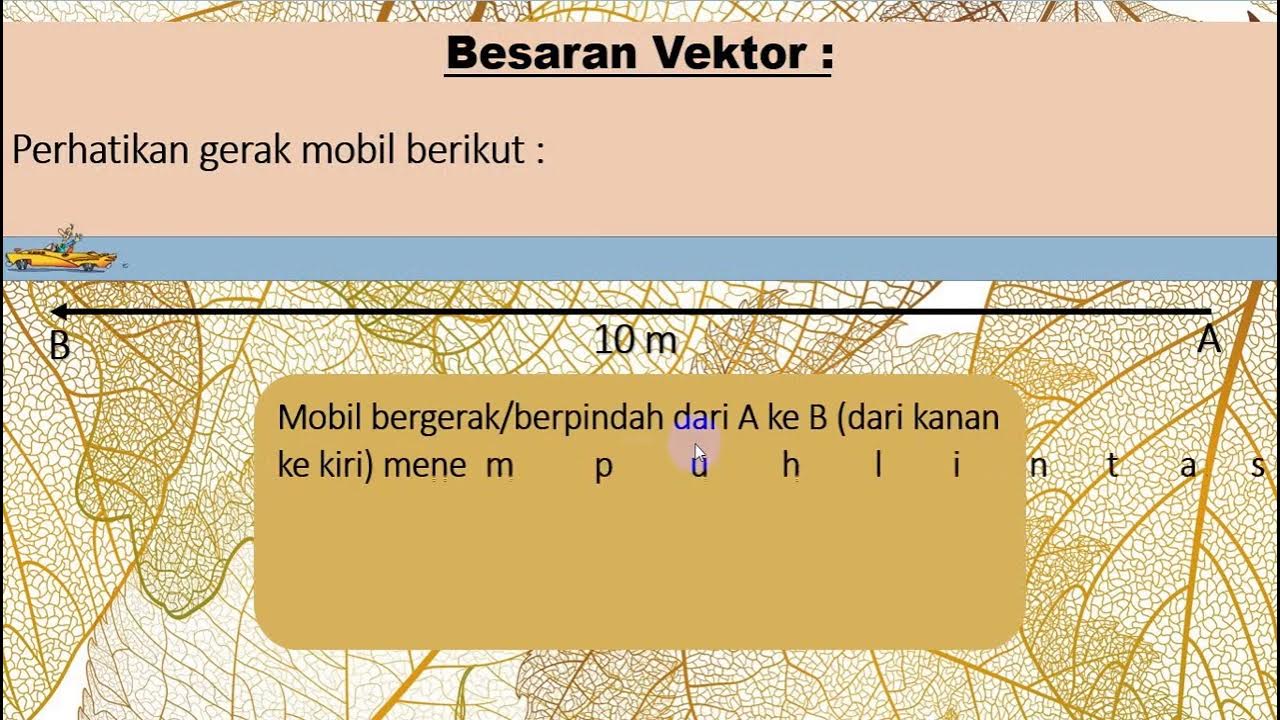Cinemática 04: Grandezas Vetoriais e Escalares
Summary
TLDRIn this lesson, the video explains the difference between scalar and vector quantities in physics. Scalar quantities are defined by just a number and a unit of measurement, such as time, mass, temperature, and area. Vector quantities, on the other hand, require a number, unit, direction, and sense, such as displacement, force, velocity, and acceleration. The video uses simple, relatable examples to illustrate these concepts, helping viewers understand how these quantities differ and how to identify them in real-world situations.
Takeaways
- 😀 Scalars are completely defined by a number and a unit of measurement, with no need for direction or sense.
- 😀 An example of a scalar quantity is time: '10 minutes' is enough to describe the duration without any further information.
- 😀 Mass is also a scalar quantity, such as '80 kg'—no need to specify direction or sense.
- 😀 Temperature is another scalar: '30 degrees' clearly defines the temperature without needing additional details.
- 😀 Area is a scalar quantity as well, such as '100 square meters'—no direction or sense required.
- 😀 A vector quantity, in contrast, is defined by a number, a unit of measurement, direction, and sense.
- 😀 An example of a vector quantity is displacement, which requires specifying not only the distance but also the direction (e.g., '100 km north').
- 😀 Force is a vector quantity because the direction in which it is applied is crucial (e.g., force applied to the left or right).
- 😀 Velocity is a vector because it involves both magnitude and direction, such as '80 km/h to the north'.
- 😀 Acceleration is also a vector quantity, affecting the speed in a specific direction, like increasing speed while moving eastward.
Q & A
What are scalar quantities defined by?
-Scalar quantities are completely defined by a number and a unit of measurement. They do not require information about direction or sense.
Can you give an example of a scalar quantity?
-An example of a scalar quantity is time. For instance, '10 minutes' is a scalar because it only involves a number (10) and a unit of measurement (minutes).
Why don't scalar quantities require direction and sense?
-Scalar quantities are defined by only a number and a unit of measurement. Since they don't depend on direction or sense, specifying direction or sense isn't necessary.
What is an example of a scalar quantity involving mass?
-An example of a scalar quantity related to mass is '80 kg'. The mass of a person is simply defined by a number and a unit (80 kg) without needing to specify direction or sense.
What is the difference between scalar and vector quantities?
-Scalar quantities are defined by just a number and unit, while vector quantities require a number, unit, direction, and sense. Direction and sense are essential for understanding vector quantities.
Can you explain the concept of vector quantities using an example?
-A vector quantity, such as displacement, is defined by a number, unit, direction, and sense. For example, '100 km to the North' specifies a displacement of 100 kilometers with a direction (North) and sense.
Why is direction and sense important for vector quantities like force?
-Direction and sense are crucial for vector quantities like force because the outcome depends on where and how the force is applied. For example, applying force to the left results in a different outcome than applying it to the right.
How is velocity a vector quantity?
-Velocity is a vector quantity because it has both a speed (number and unit) and a direction. For instance, '80 km/h to the North' specifies not just the speed but also the direction of travel.
What is acceleration and why is it a vector quantity?
-Acceleration is a vector quantity because it has both magnitude (speed increase) and direction. When you accelerate, you either speed up or change direction, which makes direction important.
How do scalar quantities differ from vector quantities in terms of measurement?
-Scalar quantities only require a number and unit for measurement, while vector quantities need additional information, such as direction and sense, to fully describe them.
Outlines

This section is available to paid users only. Please upgrade to access this part.
Upgrade NowMindmap

This section is available to paid users only. Please upgrade to access this part.
Upgrade NowKeywords

This section is available to paid users only. Please upgrade to access this part.
Upgrade NowHighlights

This section is available to paid users only. Please upgrade to access this part.
Upgrade NowTranscripts

This section is available to paid users only. Please upgrade to access this part.
Upgrade NowBrowse More Related Video

Definições de Grandezas Físicas: Escalares e Vetoriais - Principais diferenças

Besaran vektor dan besaran skalar (Fisika SMA/MA Sagufindo kls X smt 1 : Vektor)

Introdução ao Estudo da Física e Grandezas | Física - aula #1 | prof. Yuri Alves | Extensivo NPAC

A Teoria do Movimento | Episódio 2

GCSE Physics Revision "Scalar and Vector Quantities"

Grandezas vetoriais x escalares - VETORES - Aula 1 - Prof. Marcelo Boaro
5.0 / 5 (0 votes)